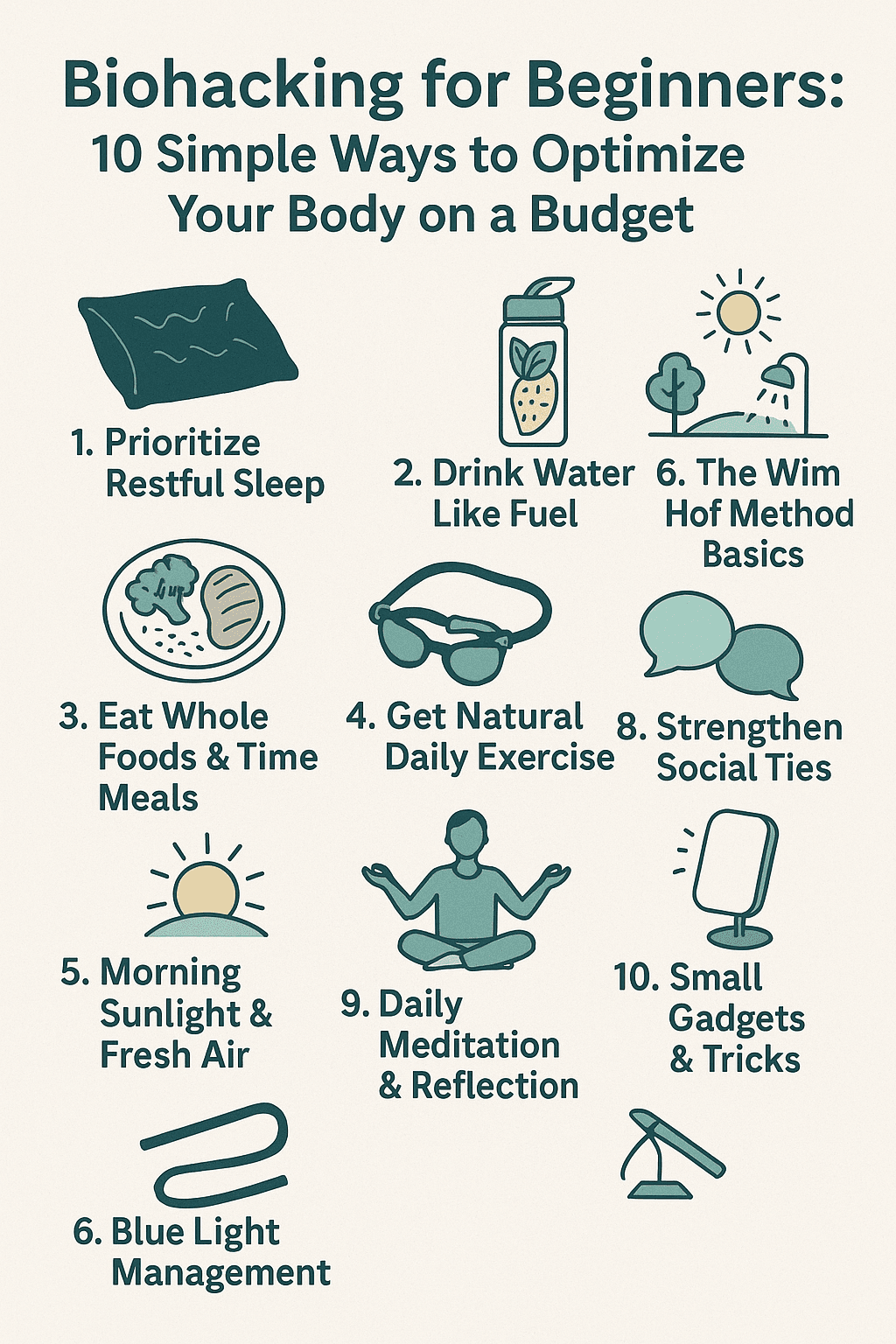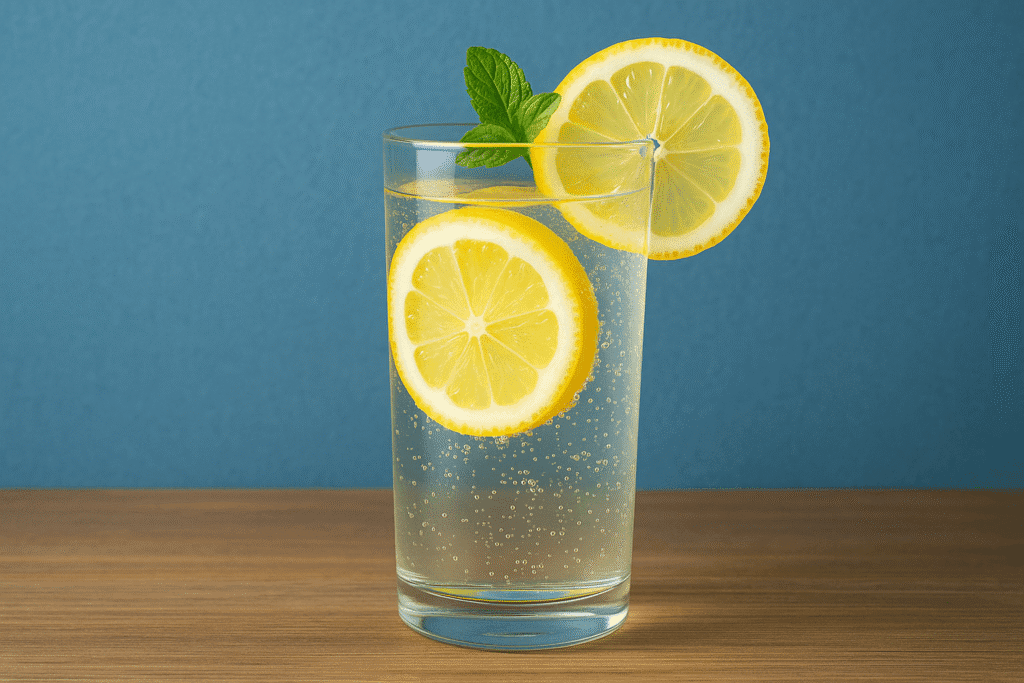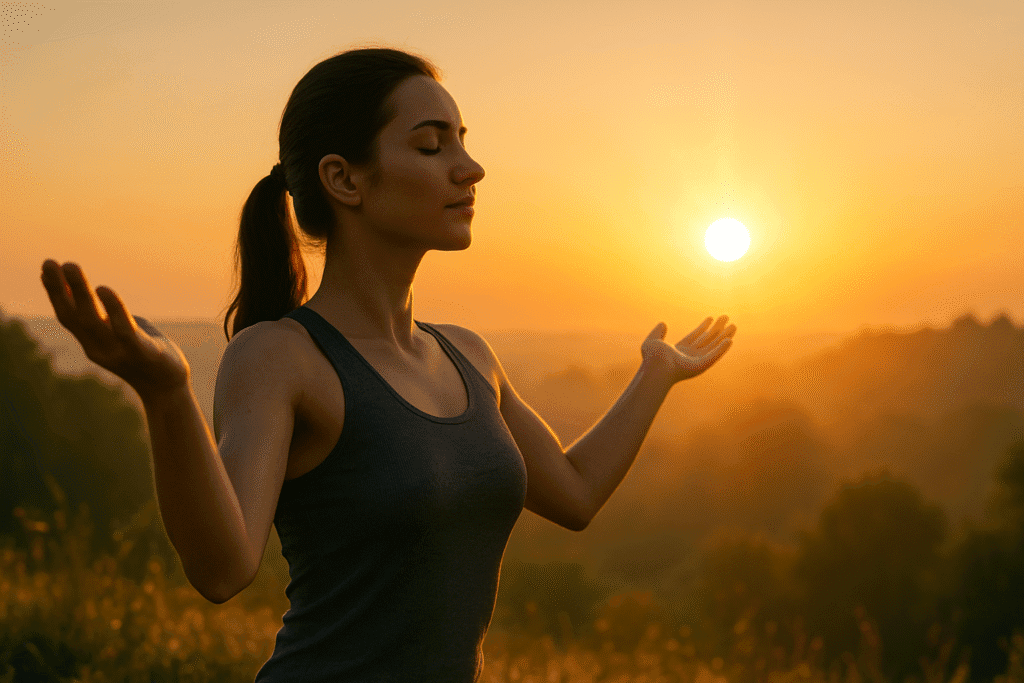Biohacking for Beginners: 10 Simple Ways to Optimize Your Body on a Budget
Ready to start biohacking on a budget? Our beginner-friendly guide shares 10 practical, low-cost hacks – from optimizing sleep and hydration to natural sunlight and cold exposure. We even explain how to start biohacking without supplements and cover what the Wim Hof method is. Let’s optimize our bodies without breaking the bank!
We often think biohacking means high-tech gadgets or spending lots of money. In reality, biohacking is simply about small tweaks to our daily habits that improve how our bodies and minds perform. It’s a growing trend – even tech billionaires like Bryan Johnson have spent millions on an anti-aging “Project Blueprint” – but the fundamentals can be done for free or on a shoestring budget. At its core, biohacking means taking control of our biology: better sleep, better nutrition, smarter movement, and so on. In fact, experts note that the fundamentals of biohacking are “free and easily available”. North America is leading the way (the U.S. dominates the global biohacking market), but anyone can join in – whether we’re in a tech-savvy US city, a laid-back Canadian town, or a practical UK suburb. In this beginner’s guide, we share 10 simple, affordable biohacks (no expensive supplements required!) to optimize your body, from better sleep and hydration to learning what the Wim Hof method is. Let’s dive in with confidence and enthusiasm – because even small changes can give big results on a budget.

1. Biohack Your Sleep: Prioritize Restful Recovery
Good sleep is the foundation of any wellness routine. Think of your body like a smartphone: if you never charge it overnight, it dies; if you charge it too fast or skip cycles, performance suffers. The same goes for us. By treating bedtime as a priority, we can supercharge our daytime energy and health. Simple changes – a consistent sleep schedule, a cool dark bedroom, and a calming pre-bed routine – can make a huge difference. For example, try dimming screens and lights an hour before bed to cue your body it’s time to rest. In fact, one expert emphasizes that just creating a special bedtime routine and a cool, dark sleep environment is “key to longevity and well-being”.
If we want an extra boost, we can add inexpensive tools: a comfortable cooling pillow or an eye mask can block out light, and a simple white-noise app or machine can drown out city sounds. : Cooling Gel Memory Foam Pillow. Even aromatherapy with lavender or a warm herbal tea (chamomile or mint) can send powerful signals to the body to relax.
Above all, staying consistent is crucial. Going to bed and waking up at roughly the same times helps align our natural circadian rhythms. As the Harley Health Center notes, “Sleep is crucial for recovery and overall health, yet many people don’t prioritize it”. By making sleep a ritual (no late-night screen scrolling!) we’re effectively biohacking our brain’s recharge mode. Sleep first, and everything else in our day goes better.
2. Biohack Hydration: Drink Water Like Fuel
Water is to our body what oil is to an engine. Without enough, everything grinds to a halt. In biohacking our health on a budget, hydration is one of the cheapest and most powerful tools we have. Even mild dehydration (losing just 1–3% of our body water) can significantly impair our mood, energy levels, memory, and mental performance. In other words, skipping that water bottle is like trying to run a marathon on fumes.
To hack this, we start by drinking regularly. Aim for the classic 8×8 rule (eight 8-ounce glasses a day) as a baseline, then adjust for your size, activity, and climate. Carry a reusable water bottle everywhere we go. We can make water more appealing and give our body extra vitamins by infusing it with lemon or cucumber slices. Adding a slice of lemon not only tastes great but also provides a tiny dose of vitamin C. Keeping a stainless steel or glass bottle on our desk or in the car becomes a constant reminder. ( Infuser Water Bottle) .
Staying hydrated is completely free (aside from the tap), yet has real effects. Studies have shown that even slight dehydration makes tasks feel harder and worsens concentration. In practice, we might notice headaches, crankiness, or brain fog on days we forget to drink. By simply sipping water throughout the day – ideally a glass first thing in the morning and another before meals – we can hack our energy. It’s a tiny habit (carry a bottle everywhere!) that pays huge dividends. Plus, herbal teas or decaf iced tea can count too (just watch added sugars). The tech culture might love fancy nootropics, but the best brain booster is a simple gulp of H₂O.

3. Biohack Your Diet: Whole Foods & Timing (No Fads Needed)
We don’t need exotic supplements or pricey shakes to eat well; smart eating can be cheap and powerful. The keyword here is whole foods. Instead of trendy diets, focus on real ingredients: fruits, vegetables, whole grains, nuts, beans, and lean proteins. Think of your body like a machine that needs quality fuel: ditch the “bad fuel” (processed junk, sugary sodas) and fill up on nutrient-rich foods. A practical tip is meal-prepping on the weekend – batch-cook rice, grilled chicken, and roasted veggies in bulk so healthy options are always at hand. It saves time and money compared to ordering fast food on demand.
A super-affordable biohack is intermittent fasting (IF) or time-restricted eating. We might skip breakfast or have a 16/8 day (eat all meals within an 8-hour window, fast 16 hours overnight). This doesn’t require buying anything – we’re just shifting when we eat, not adding products. IF has been linked to benefits like improved metabolism and mental focus. It’s easy on the wallet and simplifies meal planning. If hardcore fasting is too much, even a 12-hour overnight fast (e.g. 7pm–7am) can help regulate blood sugar and energy. As Dr. Enam Abood notes, one key benefit of IF is “bringing down your fasting insulin level”, which many people struggle with due to poor diets. Lower insulin can mean easier weight control and more stable energy.
We can also biohack by avoiding fads: skip diet pills and focus on basics. The Harley team advises, “Everything you eat should have nutritional value…avoid refined sugars, starches, bad fats, and processed food”. In practice, that means inexpensive staples like brown rice, eggs, oats, beans, and seasonal produce. A bag of frozen vegetables and a can of beans costs less per serving than fast food. A high-protein breakfast (even if just eggs and spinach) keeps us full and energetic all morning. We’re literally hacking our appetite and metabolism without spending extra.
In short, we can call this biohack “eat like a real person”. Your grandmother’s pantry (rice, beans, veggies) is full of biohacking potential – and often cheaper than a latte or energy drink habit.
4. Biohack Movement: Get Natural Daily Exercise
Moving our bodies daily is a must, but it doesn’t require a gym membership or fancy equipment. Think of our muscles as software: if we don’t update (use them), they’ll get buggy and slow. Instead, we integrate movement into life naturally. Walk or bike to work (or around the block), take the stairs, do a few squats while cooking dinner, or have a dance party in the living room. Even short bursts of activity – a 5-minute stretch routine or a quick set of push-ups – add up.
We like to treat movement as play, not punishment. For example, walking a dog, playing tag with kids or friends, gardening, or dancing while cooking all count. The Harley health experts emphasize: “Movement is a natural part of life – find ways to incorporate it into your fun activities and daily life”. It shouldn’t feel like a chore. If you enjoy it, you’ll do it more. No money spent, just creativity.
If we do want a cheap tool, resistance bands are great ($10–20 on Amazon). They take up no space and let us do dozens of strength moves at home. (: Resistance Band Set). For cardio at home, a jump rope ($5) can replace a treadmill or gym. A good yoga mat ($15) can make floor stretches more comfortable. These basics often pay for themselves in health.
Remember: consistency beats intensity. It’s better to walk 15 minutes every day than one hour once a week. Even standing up and marching in place during TV ads is a hack against sitting for hours. Over time, this daily movement supports circulation, metabolism, posture, and mood. It’s 100% free (aside from sneakers). So lace up those shoes, or take “movement breaks” at work, and treat moving as a non-negotiable part of your day.
5. Biohack Light and Air: Morning Sunlight & Fresh Air
One of the simplest biohacks comes straight from nature: sunlight. We are solar-powered creatures, and regular exposure to natural light – especially first thing in the morning – does wonders for our sleep cycle, mood, and energy. Imagine your body’s internal clock is a plant: it needs sunshine in the morning to bloom and stay in rhythm. As Dr. Enam Abood says, “Everything thrives in natural sunlight…Vitamin D is a fundamental cornerstone of wellbeing, and the sun is the best way to get it.”.
To hack our body clock, we open curtains right when we wake, or better yet, step outside for a few minutes with coffee or tea. Even in winter or on cloudy days, outdoor light (or a window) helps our brain stop making melatonin and start making cortisol at the right time. This realigns our circadian rhythm, so we feel more awake by day and sleepy by night. In summer or sunny climates, 15–30 minutes of morning sun can be enough; in darker places (hello Canada/UK winters!), we can use an affordable light therapy lamp instead (look for a 10K lux lamp on Amazon). (: Sunrise Alarm Light) helps simulate dawn in the bedroom and gradually wakes us up naturally.

Fresh air and sunlight also boost our vitamin D, a hormone that supports immunity, bone health, and even mood. Short daily breaks outside (like a lunchtime walk under daylight) do more than stretch our legs – they literally recharge our body’s biochemistry. It’s like giving our biology a wake-up call. No prescription needed. The best part? It’s literally free. By opening the shades and stepping outside, we hack our brain’s clock and mood every morning, with nothing more than sunshine and a few deep breaths of fresh air.
6. Biohack with Cold & Breath: The Wim Hof Method Basics
You’ve probably heard of the Wim Hof Method (it’s become a buzzword in biohacking circles): it’s a combo of deep breathing exercises and cold exposure (cold showers or ice baths) designed to boost energy and resilience. In practical terms, we can start by simply finishing our daily shower with 30 seconds of cold water, focusing on deep, controlled breathing (long exhales). This wakes up our nervous system and feels like hitting a reset button.
There’s some interesting science behind this hack. A 2024 analysis of studies found that Wim Hof–style breathing and cold exposure may reduce inflammation by spiking adrenaline (epinephrine) in the body. This is why practitioners report feeling a rush of clarity and energy. In other words, a cold blast + brisk breaths may dial down stress hormones and give us a natural high.
Of course, we must add a word of caution: experts warn that this method isn’t risk-free, especially for people with heart conditions. The American Heart Association advises checking with a doctor before plunging into extreme cold. As biohackers, we are careful hackers – so we start slow. A few seconds of cold at the end of a warm shower, gradually working up as we feel comfortable, is a good strategy. And always breathe calmly: hyperventilating isn’t necessary.
In everyday practice, we might say: “Cold showers are the cheapest cryotherapy.” We all have a shower, no equipment needed. For example, on mornings when we’re groggy, a 10-second cold rinse can jolt us awake (like a strong espresso without the caffeine jitters). Some people even do a short breathwork session: five minutes of slow diaphragmatic breathing can calm anxiety and improve focus – again, free. We might incorporate this hack by sitting up straight, inhaling deeply through the nose for 4–5 seconds, then exhaling slowly through the mouth for 6–8 seconds, repeating 10 times. It’s like a mental reset that fits in 2 minutes.
So while Bryan Johnson uses ice baths and lab tests for longevity, we beginners can biohack with just a cold-water splash and some mindful breaths. We’ll feel cleaner, more alert, and potentially less inflamed – all without spending a dime. Remember to listen to your body: if it feels too intense, ease off. Even cold feet under the tap count!
7. Biohack Your Screens: Blue Light Management & Digital Detox
In our tech-forward culture, screens are everywhere – which can mess with sleep and stress. We can biohack by limiting blue light and screen time, especially in the evening. Blue light from phones and computers tricks our brain into thinking it’s daytime, which delays sleep hormones.
A budget-friendly hack: install a blue-light filter app (free f.lux or the built-in “Night Shift” mode on your phone) and wear an inexpensive pair of blue-light-blocking glasses in the evening ( Blue Light Blocking Glasses). These shift our screens to warm tones after sunset, or block the blue spectrum altogether. It’s like putting sunglasses on our devices. We also make it a rule to stop looking at screens (no emails, no Netflix) at least 30 minutes before bed. Instead, read a real book, chat with a friend, or do light stretching.
Another angle is a partial digital detox during the day. A simple trick: for the first hour after waking and the last hour before sleep, go device-free. Use this time for real-world biohacks instead (like morning sun and meditation). Setting app timers or using “Do Not Disturb” modes can help us take breaks from social media and email. The body and brain will thank us with lower stress and better sleep. Plus, we often gain back time for walking outdoors, journaling, or prepping dinner – activities that physically recharge us instead of draining us.
This isn’t a glamorous tech gadget, but it’s crucial. We’re hacking our environment: controlling the artificial light and distraction around us is as important as how we sleep or eat. With a few no-cost rules and maybe an under-$20 pair of glasses, we’re tricking our biology into a more natural rhythm. That’s affordable biohacking for the digital age.
8. Biohack Connection: Strengthen Social Ties & Community
This might seem more “mental” than “bodily,” but strong social connections are proven health boosters. We include this hack because emotional well-being is tightly linked to physical health – and connecting with others is free. Studies repeatedly show that people with solid friendships and community ties live longer and have better immunity.
So we hack this by consciously spending time with friends and family. Instead of meeting a friend for lunch at a pricey café, organize a free park walk or a potluck dinner where everyone brings a dish. Join a low-cost group activity (like a community sports league or hiking club). We even frame it as a health hack: laughing and talking with people lowers stress hormones (cortisol) and pumps up feel-good ones (endorphins). The Harley Street clinic points out that a sense of belonging is “fundamental to our well-being.”.
In practice, we’d say: trade one Netflix binge for a board game night with friends once a week, or start a book club with neighbors. These are essentially free happiness hacks. We don’t cite a science paper for hugs and chats, but there’s plenty of evidence. Besides, socializing is 100% free if we keep it simple. We’re hacking our sense of support, which in turn can even improve sleep, lower blood pressure, and motivate us toward healthier habits. It’s easy to overlook, but setting aside time for people we care about is a surprisingly powerful biohack.
9. Biohack Your Mind: Daily Meditation & Reflection
Even if it’s just five minutes, taking time to slow down mentally can optimize our body. Meditation or mindfulness exercises improve focus, lower stress, and can even reduce inflammation markers. For beginners, we don’t need fancy apps or retreats – we can start with a few mindful breaths or a short guided meditation on YouTube (zero cost). Just 3–5 minutes of sitting quietly, focusing on the breath, can reset our nervous system.
Another no-tech hack is journaling. Writing down thoughts, gratitude lists, or goals is like updating our mental software. It can reduce anxiety and improve clarity. For example, note three things we’re thankful for each morning or write a quick brain-dump before bed. This practice has been linked to better mental health and even improved sleep quality. We can treat journaling as a stress detox for the mind. (: Journal Notebook – even a $5 notebook works!).
By clearing mental clutter, we biohack our stress response. Think of it as defragging your brain’s hard drive. This costs nothing but a little time. Over weeks, it pays back in better mood, sharper thinking, and more resilience to challenges (like tight deadlines or morning traffic). Plus, if meditation or journaling aligns with spiritual values, that can add another layer of well-being (for example, mindfulness came from ancient traditions).
So let’s schedule “mindfulness breaks”. That could be deep breathing for a minute at the office, or writing a gratitude list with our morning coffee. These small, free practices add up. They may not show up as physical hacks like gym reps, but they literally change our brain – rewiring it to be calmer and more focused. In biohacking, a calm mind is a powerful ally.

10. Biohack with DIY Tools: Small Gadgets & Tricks
Finally, we round out our list with a grab-bag of simple tools and tricks that cost little but feel like high-tech. For example:
- Standing or Stretching Breaks: Sitting all day is a stealth health hazard. We can “hack” this by using a box or books to raise our laptop (to stand-partially), or just setting a timer to stand and stretch for 1 minute each hour. There are affordable products like desk bikes or under-desk pedals , but even using a kitchen timer works.
- Breath-Training Devices: There are free apps or $10 devices that encourage deeper breathing (bagpipes style). But really, a cheap incentive is to simply practice blowing bubbles in water or using a straw to slow our exhale – exercises that strengthen lung function and calm us.
- Grip and Posture Tricks: Carrying a light hand-grip exerciser ($5) or wearing a posture-correcting band (under $20) can serve as reminders to engage muscles. These are optional, but act like gentle nudges to keep us active.
- DIY Bio-Feedback: We can “track” our own biology with just free apps. For example, use the smartphone flashlight and camera to check our pulse, or use free meditation apps (Insight Timer) instead of costly ones. We don’t need expensive wearables; even a free pedometer on our phone tells us step count.
These small hacks may sound trivial, but cumulatively they keep our system in tune. The key is creativity over cost. For instance, one low-tech hack is simply turning down the thermostat and wearing a sweater for a while – forcing our body to burn extra calories to stay warm (like an ice vest). It’s free calorie-burning biohacking! Or cooking with herbs like turmeric and ginger (very cheap) for their anti-inflammatory benefits.
In the spirit of Bryan Johnson’s gadget-laden approach, we’d say: “You can spend $10 on a sleep mask or $10 million on lab tests. We’re choosing the mask.” Even fancy labs and devices ultimately aim to optimize the same basics we’ve covered. So, keep an eye on smart but cheap tools, but remember: our cheapest, most effective biohacks are already within reach.
Conclusion: You’ve Got This!
Biohacking doesn’t have to mean lab coats or Michelin-star diets. As we’ve seen, the basics are incredibly affordable. By focusing on sleep, water, movement, nutrition, and smart environment tweaks, we can optimize our bodies on any budget. We encouraged Bryan Johnson-level savvy (morning sun, blood markers) without Bryan Johnson’s bank account. Remember, consistency is key – these cheap hacks compound over time.
So let’s celebrate the beginner wins: A full night’s sleep, a glass of water at our desk, a brisk walk during lunch, and a few mindful breaths are all biohacks. We invite you to pick one or two hacks from this list and try them out this week. Track how you feel (journal it, if you like!). Over time, these small changes will stack up to big improvements in energy, mood, and overall health.
We’re in this together – the rest of us on a budget, starting our biohacking journey. With confidence and a sense of fun, we can tune our bodies and minds to perform better, every day. Let’s get hacking (safely) and enjoy the gains!
FAQ
- Is biohacking safe? In general, biohacking basics (better sleep, hydration, nutrition, light exposure) are very safe and well-supported by science. Extreme practices like ice baths or untested supplements carry risks – experts advise caution with those. Our beginner tips focus on proven, gentle changes. As always, if you have a medical condition, consult a doctor before drastic changes.
- Can I biohack without supplements? Absolutely. The core of biohacking is lifestyle, not pills. In fact, the fundamentals “don’t require fancy equipment or supplements”. You can start with free resources: sunlight, whole foods, water, movement, and so on. Supplements like vitamins or nootropics are optional later – get the basics right first.
- How to start biohacking for free? We already showed you how: begin with daily habits that cost zero. For example, sleep in a dark room, drink plain water, walk outside at dawn, and practice simple breathing. Those are all free biohacks. Online resources (like meditation videos or movement tutorials) are often free too. Think of biohacking as DIY wellness: we don’t need an expensive kit, just curiosity and consistency.
Sources: Authoritative wellness and science sources informed these tips. For example, leading health sites note the importance of sleep hygiene, hydration, and natural movement for overall well-being. We cite studies and expert articles where relevant to back our advice.